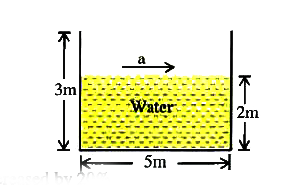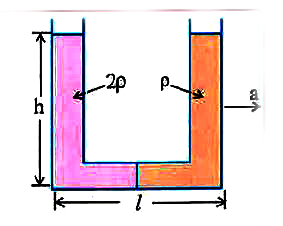A body of density 'ρ' is let force in a liquid of density d (P>d). What is the downward acceleration of the body while shaking in the liquid ?Solution in Telugu
[I−dρ]g
Topper's Solved these Questions
- FLUID MECHANICSBook:AAKASH SERIESChapter:FLUID MECHANICSExercise:Numerical Exercise (LEVEL-2)
Explore 18 Videos
- FLUID MECHANICSBook:AAKASH SERIESChapter:FLUID MECHANICSExercise:Questions for Descriptive Answers
Explore 14 Videos
- FLUID MECHANICSBook:AAKASH SERIESChapter:FLUID MECHANICSExercise:Very Short Answer Type Questions
Explore 28 Videos
- EXPANSION OF SOLIDS Book:AAKASH SERIESChapter:EXPANSION OF SOLIDS Exercise:Questions for Descriptive Answers
Explore 5 Videos
- FRICTION Book:AAKASH SERIESChapter:FRICTION Exercise:ADDITIONAL PRACTICE EXERCISE PRACTICE SHEET (ADVANCED) (MORE THAN ONE CORRECT ANSWER TYPE QUESTIONS)
Explore 1 Video
Similar Questions
An open rectangular ank 5m×4m×3m high containing water upto a height of 2m is accelerated horizontally along the longer side (a) Determine the maximum acceleration that can be given without spilling the water.
(b) Calculate the percentage of water split over, if this accelerationis increased by 20%
(c ) If initially the tank is closed at the top and is accelerated horizontally by 9m/s2, find the gauge pressure at the bottom of the front and rear walls of the tank.

View SolutionA U-tube of base length I filled with same volume of two liquids of densities ρ and 2ρ is moving with an acceleration a on the horizontal plane. If the height difference between the two surfaces (open to atmosphere)becomes zero,then find height h

View SolutionWhy canals are constructed in 'V' shape? Explain.
View SolutionThe length of an iron rod is measured by a brass scale. When both of them are at 20∘C, the length is 80 cm. What is the length of the rod at 100∘C as measured by the scale at 100∘C? The coefficient of linear expansion of brass and iron are 24×10−6(C∘)−1and18×10−6(C∘)−1 respectively.
View Solutionif the man can move with maximum acceleration a1anda2 relative to the trolley car in forward and backward directions, respectively then :
View SolutionA drop of liquid of density rho is floating half-immersed in a liquid of density d . If rho is the surface tension the diameter of the drop of the liquid is
View SolutionA drop of liquid of density ρ is floating half-immersed in a liquid of density d. If ρ is the surface tension the diameter of the drop of the liquid is
View SolutionA sphere of density d is let fall in a liquid of density d4. The acceleration of the body will be
View SolutionA body of density 2.5 g//cm^(3) is let free in a liquid of density 1.25 g//cm^(3) . The downward acceleration of the of the body while sinking in the liquid is . _______
View SolutionA spherical body of density rho is floating half immersed in liquid of density d, if alpha is the surface tension of the liquid, then the diameter of the body is
View SolutionA body of density ρ is placed slowly on the surface of a liquid of density δ. If the depth of the liquid is d, then prove that the time taken by the body to reach the bottom of the liquid is [2dρg(ρ−δ)]1/2 second.
View SolutionWhen a body of density rho and volume V is floating in a liquid of density sigma
View SolutionA body of density D is droped gently on the surface layer of liquid of density 'd' and depth 'h'. If D > d, the downward acceleration of the body while sinking is :
View SolutionDrops of liquid of density d are floating half immersed in a liquid of density rho . If the surface tension of liquid is T then the radius of the drop will be (d = density of liquid drop)
View SolutionA sphere of density d is allowed to fall in a liquid of density d/4. The acceleration of the body will be
View Solution